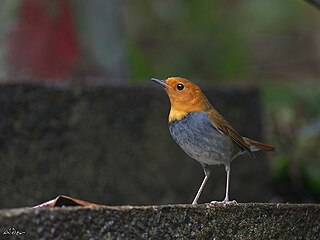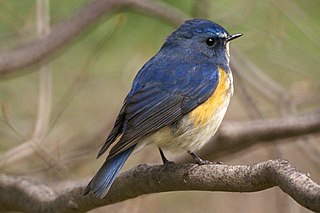
The Japanese robin is a small passerine bird in the family Muscicapidae. This species was formerly named Erithacus akahige, or Komadori. Its range extends from the south of the Kuril and Sakhalin Islands throughout Japan.

The red-flanked bluetail, also known as the orange-flanked bush-robin, is a small passerine bird that was formerly classed as a member of the thrush family Turdidae, but is now more generally considered to be an Old World flycatcher, Muscicapidae. It, and related species, are often called chats.

The Old World flycatchers are a large family, the Muscicapidae, of small passerine birds restricted to the Old World, with the exception of several vagrants and two species, bluethroat and northern wheatear, found also in North America. These are mainly small arboreal insectivores, many of which, as the name implies, take their prey on the wing. The family is relatively large and includes 351 species, which are divided into 54 genera.

The chestnut-backed antbird is a passerine bird in subfamily Thamnophilinae of family Thamnophilidae, the "typical antbirds". It is found in Colombia, Costa Rica, Ecuador, Honduras, Nicaragua, and Panama.
The Sangha forest robin is a subspecies of the forest robin that is endemic to south-western Central African Republic, but may also occur in adjacent parts of DR Congo, Cameroon and Republic of the Congo. It was only discovered in 1996, and scientifically described in 1999. When recognized as a species by IUCN, it was considered data deficient, but following recommendations by the BirdLife Taxonomic Working Group, IUCN now consider it a subspecies of the forest robin. It has been described as common. Clements includes this subspecies in the yellow-breasted forest robinspecies group, Stiphrornis mabirae.

The Nilgiri blue robin, also known as Nilgiri shortwing, white-bellied shortwing, Nilgiri sholakili or rufous-bellied shortwing is a species of passerine bird in the family Muscicapidae endemic to the Shola forests of the higher hills of southern India, mainly north of the Palghat Gap. This small bird is found on the forest floor and undergrowth of dense forest patches sheltered in the valleys of montane grassland, a restricted and threatened habitat.

The red-capped robin-chat or Natal robin is a species of passerine bird belonging to the family Muscicapidae. This species is found in Southern and Eastern Africa.

The azure-crested flycatcher or the blue-crested flycatcher, is a species of bird in the monarch flycatcher family Monarchidae. It is endemic to Fiji, where it is found on Taveuni.

The leaden flycatcher is a species of passerine bird in the family Monarchidae. Around 15 cm (6 in) in length, the male is lustrous azure with white underparts, while the female possesses leaden head, mantle and back and rufous throat and breast. It is found in eastern and northern Australia, Indonesia, and Papua New Guinea. Its natural habitat is subtropical or tropical mangrove forests in the northern parts of its range, in the south and inland it is eucalypt woodland.

The rufous-bellied niltava is a species of bird in the family Muscicapidae.

Güldenstädt's redstart also sometimes called the white-winged redstart, is a species of bird in the genus Phoenicurus, family Muscicapidae. It is found in the high mountains of the southwestern and central Palearctic in the Caucasus, Karakoram, Pamir, Himalaya, Tian Shan, and Altai, in the countries of Afghanistan, Armenia, Azerbaijan, Bhutan, China, Georgia, India, Iran, Kazakhstan, Mongolia, Nepal, Pakistan, Russia, Tajikistan, Turkmenistan, and Uzbekistan.

Swynnerton's robin is a species of passerine bird belonging to the family Muscicapidae. It is monotypic within the genus Swynnertonia. The common and Latin names commemorate the entomologist Charles Swynnerton.

The orange-breasted trogon is a species of bird in the family Trogonidae. It is a colorful, sedentary species that inhabits the lower canopy of the lowlands and forest of southern China, southeast Asia, Borneo, Sumatra and Java.

The orange-bellied trogon is a subspecies of the collared trogon in the family Trogonidae. It is now usually considered as a morph of the collared trogon, but was previously sometimes treated as a separate species. It is found in the Talamancan montane forests of Costa Rica and Panama.

The white-bellied blue robin or white-bellied sholakili, is a bird of the family Muscicapidae. It is endemic to the Shola forests of the higher hills of southern India. The Nilgiri blue robin and this species were once considered separate species, later lumped as sub-species of a single species (major) and elevated again to full species in 2005 by Pamela C. Rasmussen. The species was earlier thought to be related to the shortwings and placed in the genus Brachypteryx and later moved to Myiomela since species in the genus Brachypteryx shows marked sexual dimorphism. In 2017, a study found that this is a sister group of the flycatchers in the genera Niltava, Cyornis and Eumyias among others. It was then placed in newly erected genus Sholicola. This small bird is found on the forest floor and undergrowth of dense forest patches sheltered in the valleys of montane grassland, a restricted and threatened habitat.

The olive-backed forest robin is a subspecies of the forest robin found in the Gamba Complex in southwest Gabon. It was described in 2008. The olive-backed forest robin can be separated from other subspecies of the forest robin by the combination of its olive upperparts, bright orange throat and chest, and cream-yellow belly. Its song is also distinct from other subspecies of the forest robin. Females are generally duller than males. It has not been evaluated by IUCN, but has been described as locally common.

The western forest robin is a subspecies of the forest robin found at low levels in West African forests from Sierra Leone to Nigeria. It has been placed in the family Turdidae, but is now generally placed in Muscicapidae. It commonly includes the other members in the genus Stiphrornis as subspecies, in which case the common name for the "combined species" simply is forest robin. The western forest robin can be separate from the other members of the genus by the combination of its deep orange throat and breast, white belly, and olive upperparts. It also appears to differ vocally from the other members in the genus, but a comprehensive study on this is lacking. When considered conspecific with the other members from its genus, S. erythrothorax is considered to be of least concern by IUCN. While not rated following the split into several species, it has been described as frequent to locally abundant, and is therefore unlikely to qualify for a threatened category.

The Gabon forest robin is a subspecies of the forest robin found at low levels of forests in Cameroon, Gabon and Bioko. In 1999 it was recommended that it should be treated as a separate species instead of a subspecies. IUCN and some other authorities do not recognize the split, and consequently it has not been rated as species separate from the forest robin. However, it has been described as frequent to locally abundant, and is therefore unlikely to qualify for a threatened category.

The eastern forest robin is a subspecies of the forest robin found at low levels in forests from Cameroon and Gabon to DR Congo and Uganda. In 1999 it was recommended that it should be treated as a separate species instead of a subspecies. IUCN and some other authorities do not recognize the split, and consequently it has not been rated as species separate from S. erythrothorax. However, it has been described as frequent to locally abundant, and is therefore unlikely to qualify for a threatened category.


















